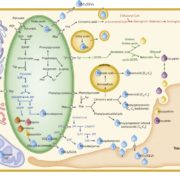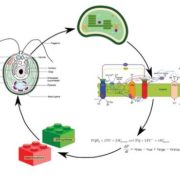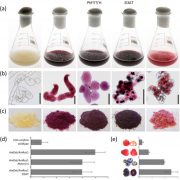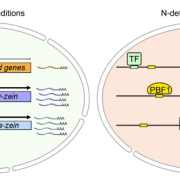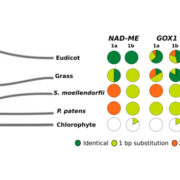What We’re Reading: January 19th
This week’s papers were seleted by Renee Dale. Renee is a PhD student in biology and an MS student in statistics at Loiusiana State University who is studying mathematical biology and biostatistics for plant biology applications. She is also working on an educational video game!
Renee selected these papers to draw attention to the application of mathematics to plant biology. “Mathematical methods in plant biology – probability, statistics, discrete and continuous mathematical models are used to study plant growth, development, gene regulation, and metabolism. The methods described in these articles provide analytical frameworks in addition to predicting and suggesting new avenues for experimental study.” These are some great papers to consider in light of the recent Commentary by Friesner et al. on the need to integrate quantitative skills into the teaching of plant biology.
Adjustment of the Arabidopsis circadian oscillator by sugar signalling dictates the regulation of starch metabolism
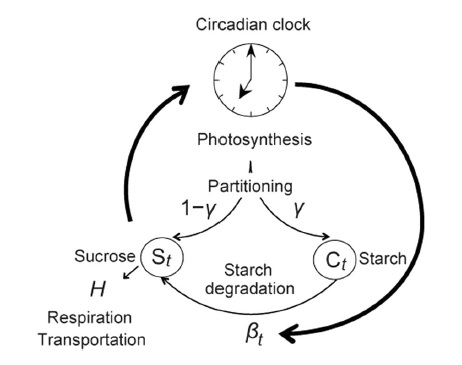 Both starch degradation and accumulating sucrose levels are related to the circadian cycle, although it is unknown which is the primary regulator. The authors created a mathematical model wherein the circadian oscillator responds to sucrose. The model predictions were experimentally validated using a sugar-insensitive mutant (ppr7-11). Sci Reports. 10.1038/s41598-017-08325-y
Both starch degradation and accumulating sucrose levels are related to the circadian cycle, although it is unknown which is the primary regulator. The authors created a mathematical model wherein the circadian oscillator responds to sucrose. The model predictions were experimentally validated using a sugar-insensitive mutant (ppr7-11). Sci Reports. 10.1038/s41598-017-08325-y
Modeling the metabolism of Arabidopsis thaliana: Application of network decomposition and network reduction in the context of Petri nets
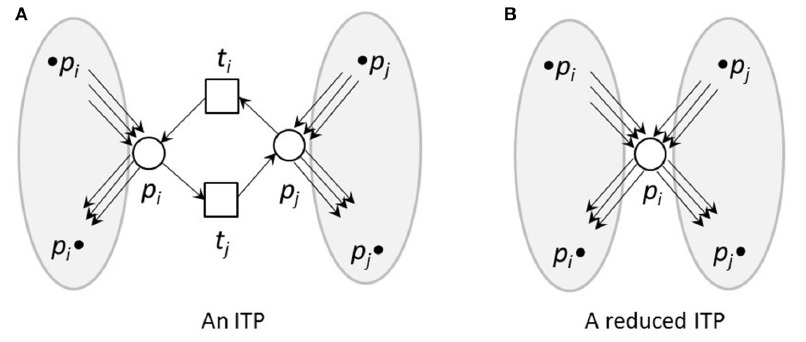 In this paper, the authors model the metabolism in Arabidopsis using Petri nets (PN). PNs are dynamic models that use “tokens” to represent movement between the places and edges of the model, representing the products of a reaction. The model was simplified using reduction techniques, and divided into four subnetworks: sucrose, citrate, UTP, and shikimate. The model provides an interpretation framework for the whole metabolic network and suggests some steady-state pathways and between-subnetwork dependencies. Front. Genetics 10.3389/fgene.2017.00085
In this paper, the authors model the metabolism in Arabidopsis using Petri nets (PN). PNs are dynamic models that use “tokens” to represent movement between the places and edges of the model, representing the products of a reaction. The model was simplified using reduction techniques, and divided into four subnetworks: sucrose, citrate, UTP, and shikimate. The model provides an interpretation framework for the whole metabolic network and suggests some steady-state pathways and between-subnetwork dependencies. Front. Genetics 10.3389/fgene.2017.00085
Probing the stochastic property of endoreduplication in cell size determination of Arabidopsis thaliana leaf epidermal tissue
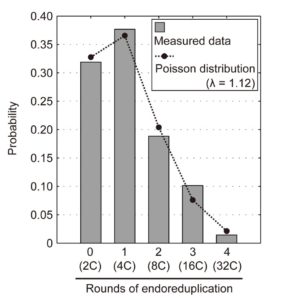 Endoreduplicated cells grow in size as their DNA content increases. The distribution of size was observed to be Poisson. This allowed the authors to create a mathematical model with a single parameter which describes the probability of exiting endoreduplication. The model recovers cell size distributions observed in Arabidopsis. PLOS One 10.1371/journal.pone.0185050
Endoreduplicated cells grow in size as their DNA content increases. The distribution of size was observed to be Poisson. This allowed the authors to create a mathematical model with a single parameter which describes the probability of exiting endoreduplication. The model recovers cell size distributions observed in Arabidopsis. PLOS One 10.1371/journal.pone.0185050
A mathematical model of the interaction of abscisic acid, ethylene and methyl jasmonate on stomatal closure in plants
 Plant stomatal opening is controlled by phytohormones, among other factors. This article models the phytohormone signaling response in guard cells using ordinary differential equations (ODEs). Sixteen components in this system were analyzed by constructing 16 different models and determining the ability of these models to recover previous findings. The resulting best model showed the effects of crosstalk between the phytohormones on stomatal closure. PLOS One 10.1371/journal.pone.0171065
Plant stomatal opening is controlled by phytohormones, among other factors. This article models the phytohormone signaling response in guard cells using ordinary differential equations (ODEs). Sixteen components in this system were analyzed by constructing 16 different models and determining the ability of these models to recover previous findings. The resulting best model showed the effects of crosstalk between the phytohormones on stomatal closure. PLOS One 10.1371/journal.pone.0171065
Predicting gene regulatory networks by combining spatial and temporal gene expression data in Arabidopsis root stem cells
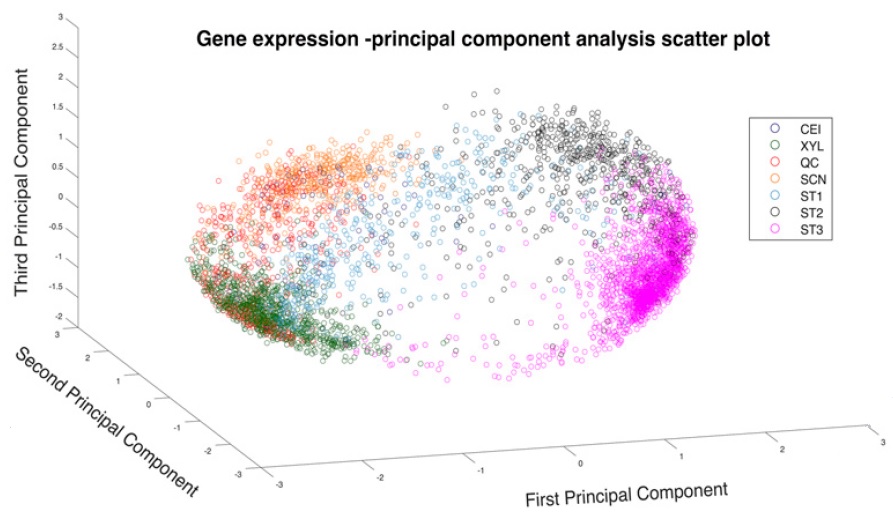 GENIST (GEne regulatory Network Inference from SpatioTemporal data) is a new algorithm developed by de Luis Balaguer et al. to predict new gene interactions and transcriptional regulators (available at https://github.com/madeluis/GENIST). The algorithm combines inference of a dynamic Bayesian network (DBN) and clustering using principal component analysis (PCA) using spatial and temporal expression data. In silico testing revealed that GENIST out-performed other methods. GENIST was experimentally validated by the successful prediction of a root stem cell regulator in Arabidopsis. Proc. Natl Acad. Sci. USA 10.1073/pnas.1707566114
GENIST (GEne regulatory Network Inference from SpatioTemporal data) is a new algorithm developed by de Luis Balaguer et al. to predict new gene interactions and transcriptional regulators (available at https://github.com/madeluis/GENIST). The algorithm combines inference of a dynamic Bayesian network (DBN) and clustering using principal component analysis (PCA) using spatial and temporal expression data. In silico testing revealed that GENIST out-performed other methods. GENIST was experimentally validated by the successful prediction of a root stem cell regulator in Arabidopsis. Proc. Natl Acad. Sci. USA 10.1073/pnas.1707566114
Dissecting and modeling zeaxanthin- and lutein-dependent nonphotochemical quenching in Arabidopsis thaliana
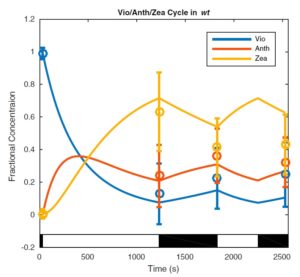 Xanthophylls zeaxanthin and lutein are involved in the nonphotochemical quenching (NPQ) pathway which is triggered in response to excess photons. The roles of zeaxanthin and lutein in NPQ are studied using mathematical models and Arabidopsis mutants. The authors hope that future refinement of the model will provide a prediction of the optimal xanthophyll content for quenching. Proc. Natl Acad. Sci. USA 10.1073/pnas.1704502114
Xanthophylls zeaxanthin and lutein are involved in the nonphotochemical quenching (NPQ) pathway which is triggered in response to excess photons. The roles of zeaxanthin and lutein in NPQ are studied using mathematical models and Arabidopsis mutants. The authors hope that future refinement of the model will provide a prediction of the optimal xanthophyll content for quenching. Proc. Natl Acad. Sci. USA 10.1073/pnas.1704502114
A new discrete dynamic model of ABA-induced stomatal closure predicts key feedback loops
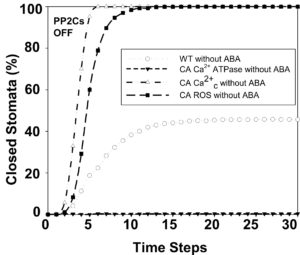 This article describes a stochastic mathematical model of the stomatal closure network responding to abscisic acid (ABA). The Boolean network is constructed from a comprehensive literature review of the components’ dependencies. The model’s predictions agree with experimental data 90% of the time, and provides predictions in 85 additional cases. Code is available here: https://github.com/krhyyme/ABA-Boolean-Network-Model. PLOS Biol. 10.1371/journal.pbio.2003451
This article describes a stochastic mathematical model of the stomatal closure network responding to abscisic acid (ABA). The Boolean network is constructed from a comprehensive literature review of the components’ dependencies. The model’s predictions agree with experimental data 90% of the time, and provides predictions in 85 additional cases. Code is available here: https://github.com/krhyyme/ABA-Boolean-Network-Model. PLOS Biol. 10.1371/journal.pbio.2003451


